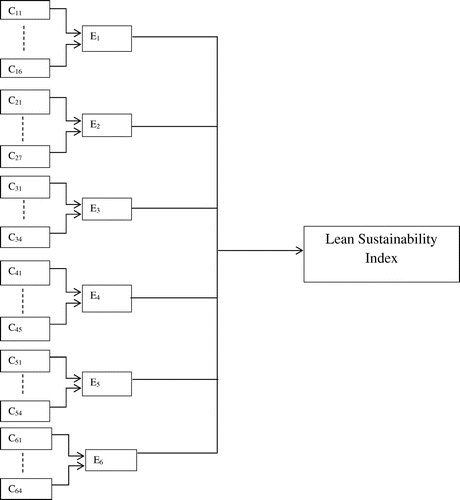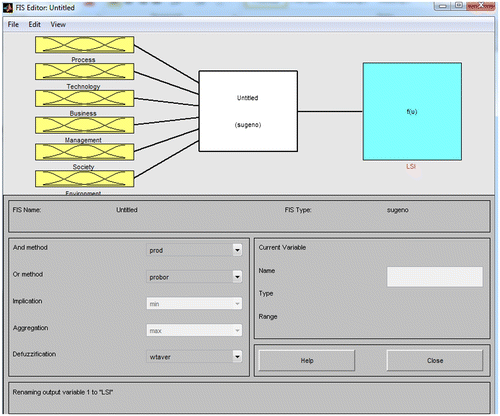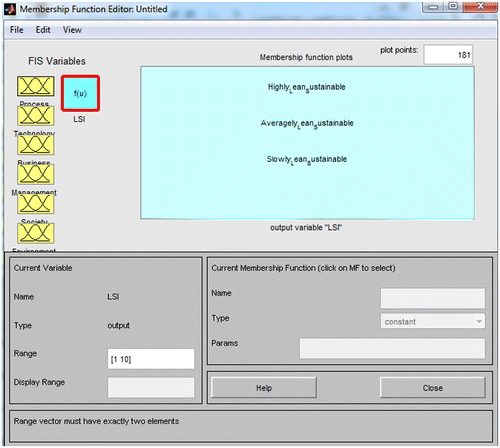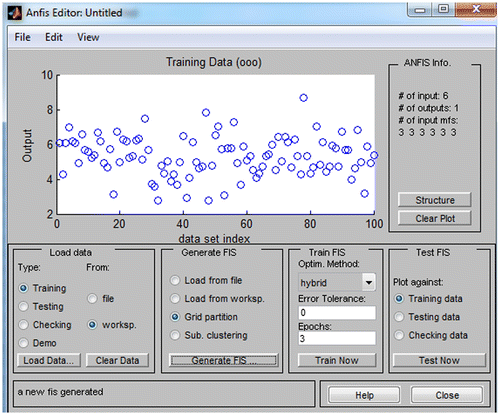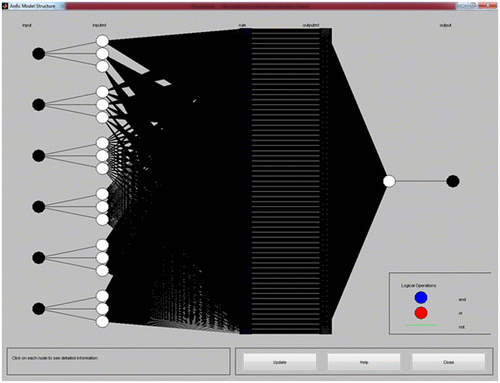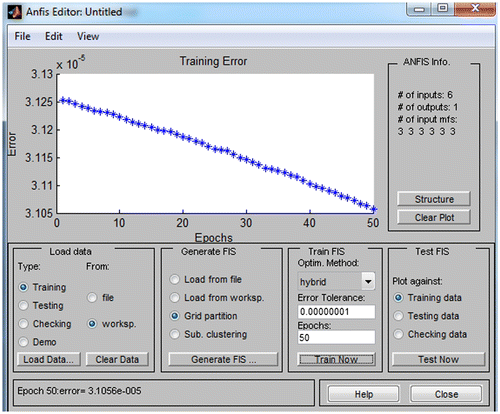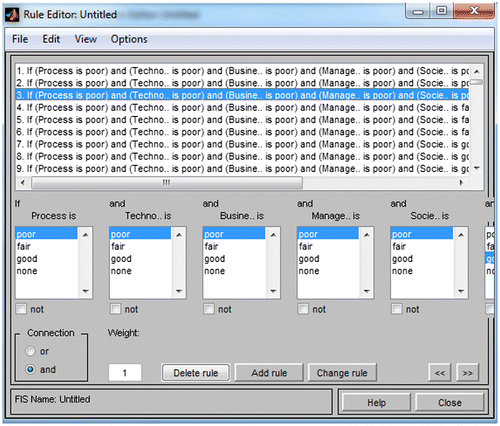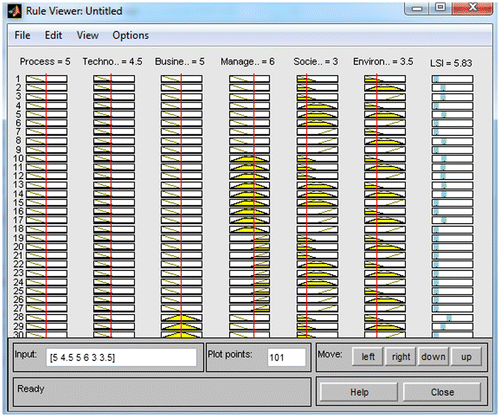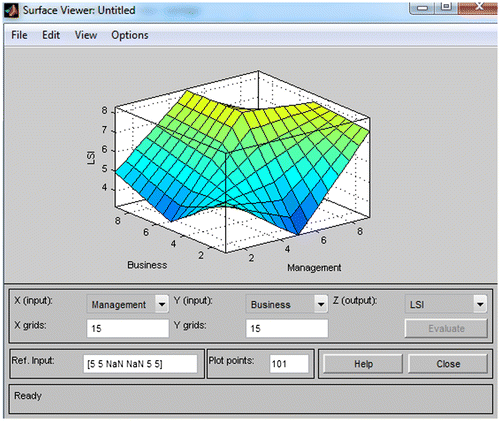Abstract
The modern manufacturing organisations have been adopting both lean and sustainable manufacturing paradigms to survive in the competitive environment. Lean and sustainable strategies aim at achieving productivity improvement by streamlined processes and waste elimination. The performance of such integrated lean sustainable system has to be assessed to ensure whether the strategic objectives are in line with customer value and to identify improvement opportunities that enable and enhance the competitive advantage of an integrated lean sustainable system. This paper presents the formulation of conceptual performance evaluation model to assess lean sustainable systems. Appropriate performance indicators have been identified and adaptive neuro fuzzy inference system approach is used to evaluate lean sustainability. A case of automotive component manufacturing firm in Indian scenario is exemplified. Based on the evaluation, lean sustainability index was computed and the firm was found to be ‘Averagely Lean Sustainable’. Further improvement actions to enhance the lean sustainable performance were planned and implemented. The developed performance evaluation model is capable of effectively evaluating the lean sustainable performance of manufacturing firms and has more practical relevance.
1. Introduction
Lean philosophy comprises several manufacturing practices that include cellular manufacturing, just in time production and quality systems in a single system (Shah and Ward Citation2003; Katsamaki and Bilalis Citation2012; Gîfu et al. Citation2014). During recent years, lean philosophy has attained popularity in manufacturing and service sectors due to its consistency in eliminating wastes and providing quantifiable benefits. Manufacturing firms focus on reducing costs and constraints caused by regulations and try to adopt a proactive methodology. Lean manufacturing as a proven methodology supports sustainability business case and when a firm’s sustainability goals are aligned in a lean path, lean can also be deployed successfully (Piercy and Rich Citation2015). Sustainable manufacturing focuses to meet the needs of the present without compromising the ability of future generations to meet their own needs (Abdul Rashid, Evans, and Longhurst Citation2008; Jayal et al. Citation2010). Sustainability implies achieving a balance between utilisation of resources to satisfy the needs of present without compromising resources for future usage (Haavaldsen et al. Citation2014; Vinodh, Ruben, and Asokan Citation2016). Three main pillars of sustainability include society, environment and economy (Wever, Van Kuijk, and Boks Citation2008). For achieving sustainability, the environmental, economic and social aspects have to be tuned and checked against each another (Kloepffer Citation2008).The contemporary manufacturing organisations are expected to be lean encompassed with sustainability characteristics. This situation is due to changing customer preferences coupled with manufacturing complexities and government regulations. As the organisation starts to incorporate lean and sustainability concepts to its core business operations, improvements are observed in terms of process efficiency, equipment efficiency and waste reduction. It also eliminates the unsound environmental and operational practices that exist in the current manufacturing systems and helps in building an efficient and profitable business system (Aguado, Alvarez, and Domingo Citation2013; Alvandi et al. Citation2016). Integrating lean manufacturing with sustainability helps in waste minimisation and also provides triple bottom line (TBL) benefits (Devika, Jafarian, and Nourbakhsh Citation2014; Vimal, Vinodh, and Muralidharan Citation2015). Lean offers a wide set of sustainable outcomes that include cost savings, product quality improvement, increased market share, invading new markets, improving employee involvement and improving public relations (Zhu and Sarkis Citation2004). An integrated model for lean sustainable performance evaluation suited for industrial compatibility was developed and validated using a study done in an automotive firm. Performance evaluation is essential to measure actual performance against expected performance. It helps in enhancing employee motivation and commitment and identifies process improvement activities. Rating scale, critical incidents and management by objectives are the widely used traditional performance evaluation methods (Wiese and Buckley Citation1998). Rating scale performance evaluation method is the widely accepted evaluation method for evaluating business systems as it evaluates the whole system considering the key appraisal areas and provides a quantitative result. Traditional evaluation methods are inaccurate and error prone. The ambiguity and vagueness of the evaluation model may increase proportionally with the number of data-sets in case of traditional evaluation. To overcome these shortcomings, a rating scale with an artificial neural network-based performance evaluation model may be used for attaining an efficient and accurate performance evaluation without uncertainty. The performance of amalgamated lean sustainable system needs to be evaluated to ensure alignment of activities with the organisation’s strategic objectives and supports the lean and sustainable initiatives that are practiced presently. It also helps in identifying improvement activities that must be followed to enhance and improve the current system. Appropriate enablers and criteria for lean sustainability have been identified from literature and used. As the indicators are vague and uncertain and due to non-availability of complete information, adaptive neuro fuzzy inference system (ANFIS) approach is used. ANFIS is an artificial neural network (ANN) which integrates principles of fuzzy logic and neural networks to ensure combined benefits. Artificial neural networking (ANN), radial-based neural network (RBNN) (Karayiannis and Mi Citation1997; Spooner and Passino Citation1999) and optimisation tool box-generated fuzzy inference system (GENFIS 1, 2) (Malhotra and Malhotra Citation2002) are some of the other commonly used performance assessment techniques. In this assessment, ANFIS is used as it is possible to obtain an efficient and optimal result as the parameters are obtained by genetic algorithm. The ANFIS uses a hybrid learning structure compared to other neural networks and arrives at a crisp value of output (Ertay and Çekyay Citation2005; Lee Citation2008). By employing a hybrid learning algorithm like ANFIS, it is possible to enhance the quality of the contributed architecture based on input–output representation of the complex system and the generated if-then rules obtained from human expertise. ANFIS also reduces the complex calculations that have to be performed on fuzzy logic when more number of variants are to be added to improvise the model. Error parameters like maximum errors, total error and average of error are minimum while performing calculations using ANFIS compared to other methods like fuzzy Logic and artificial neural network (ANN). ANFIS also permits to alter the score in ANFIS ruler to find the effect of change in the crisp data subjective to change in an input value. Finally, using ANFIS, it is possible to achieve an error-free crisp data, i.e. LSI, and also makes it possible to compute LSI when one or more input value is changed. Previously, ANFIS has been deployed to evaluate the performance of project management techniques (Bermudez Peña et al. Citation2015), supply chain performance (Thipparat Citation2012) and agility assessment (Poonacha and Bhattacharya Citation2012). The present study reports the development of an integrated lean sustainability performance evaluation model to measure the performance of a lean sustainable system. ANFIS approach was used for performing the calculation and LSI was computed. The developed model was validated with a case study done in a manufacturing organisation involved in automotive component fabrication. The lean sustainability level of the organisation was computed and their inferences are derived.
2. Literature review
The literature is reviewed based on perspective of evaluation of integrated studies on lean and green/sustainable strategies. Research articles that are frequently cited in the literature on leanness evaluation, sustainability evaluation and usage of multi-criteria decision-making (MCDM) techniques for performance evaluation that are in relevance to scope and classification of the study were the main constituents. Articles were collected from peer-reviewed journals and conference proceedings. Articles and information from unpublished working papers, dissertation thesis and text books were excluded. Leanness evaluation, sustainability evaluation, fuzzy logic-based evaluation, MCDM techniques for performance evaluation and factors and indicators for lean and sustainability evaluation are some of the keywords used in literature search.
2.1. Review on integration of lean and green/sustainable manufacturing
Pineda-Henson and Culaba (Citation2004) developed a set of indicators to evaluate the correlation of environmental parameters and operational parameters to assure green productivity. The developed productivity approach needs the deployment of cleaner production techniques and the development of vital factors to evaluate environmental performance that ensures delivering operational excellence. Kleindorfer, Singhal, and Wassenhove (Citation2005) analysed the synergies of operations and sustainable manufacturing. They studied about the effect of lean on environment, economy and society. The findings revealed that the benefits experienced after implementing lean principles also help in enhancing the sustainable performance and provide TBL benefits. Jørgensen et al. (Citation2007) performed a study to examine the possibility of integrating lean manufacturing and sustainability concepts. From the study, it was evident that lean production also offers sustainable benefit that impacts the environment, finance and society positively. Further, lean sustainability can be attained by proper capability development by defining the measures and indicators.
Herrmann, Bergmann, and Thiede (Citation2009) analysed the interdependencies among lean production and ecological factors. An approach based on simulation was developed to analyse the effects of lean production factors on environmental and economic factors. The results showed that lean production also aims at improvising economic and environmental objectives by optimising the parameters of cost, time, quality and flexibility. Miller, Pawloski, and Standridge (Citation2010) conducted a case study by implementing principles of lean production and sustainable manufacturing in a furniture manufacturing company to achieve operational success and sustainable benefits. Models like discrete event simulation and mathematical optimisation were used to conduct the quantitative analysis and significant cost savings and improved sustainability measures were observed. Yang, Hong, and Modi (Citation2011) analysed the relationship among lean manufacturing and environmental management practices. They also developed a hypothetical model to find the effect of lean on environmental management measures that have a positive impact on finance and market performance. Based on the study, a lean operation when combined with environmental management has greater potential to improve a firm’s business outcomes. Pampanelli, Found, and Bernardes (Citation2014) developed a lean green model which uses kaizen approach to improve the energy flows in manufacturing organisations. The developed model was incorporated with lean thinking principles and obtained results were favouring to reduce resource consumption and to improve environmental performance. Faulkner and Badurdeen (Citation2014) developed a mapping tool named sustainable value stream map that captures the lean measures along with sustainable measures. The developed comprehensive methodology helped in visually presenting the current scenario and helped in identifying improvement activities pertaining to both lean and sustainable characteristics. Piercy and Rich (Citation2015) explored the connection between lean principles and sustainable benefits as lean waste reduction also delivers environmental benefits. They developed an integrative stage-based model of lean and sustainable operations. The study revealed that internal and external policies, procedures, tools and strategies followed during implementation of lean principles must be streamlined in a way such that it also influences the sustainable outcomes to experience integrated benefits. Wu et al. (Citation2015) designed a model based on lean, green and societal metrics to offer TBL benefits. The developed model was validated with a field study and results proved that lean, environmental and social practices have changes and overlaps and more detailed studies are required to examine these practices to explore a combination to ensure sustainable performance.
2.2. Research gap
Based on the review, it is found that various research articles have reported about the assessment of leanness and sustainability individually using different methods. Few studies have been attempted on integration of lean and sustainable manufacturing concepts. It is determined that no substantial research is being reported on integrated performance evaluation model for assessment of lean and sustainable performance. Review also indicated that applications of fuzzy inference system (FIS) for performance evaluation overcome the vagueness and imprecise nature that exist with traditional performance evaluation methods. Based on these insights, the present study reports the development of FIS using ANFIS for lean sustainability performance evaluation. Also, computation of integrated index for lean sustainability performance was performed using ANFIS and improvement activities for lean sustainability performance enhancement are initiated and implemented. As the performance evaluation of an integrated lean sustainable system is not yet performed, the selected factors were collected from literature on leanness evaluation and sustainability evaluation. The enablers and attributes collected from literature are basically performance evaluation factors that are used for leanness and sustainability evaluation. The enablers and criteria used in this model were selected from the literature such that they possess a strong impact on improving the performance of lean sustainability and have similarities in delivering integrated benefits. The review on selection of lean sustainability assessment criteria based on various research studies is shown in Table .
Table 1. List of enablers and criteria for lean sustainability assessment from various research articles.
3. Adaptive neuro fuzzy inference system
ANFIS is a class of an ANN which combines fuzzy sets with crisp functions in forming the output (Sugeno and Takagi Citation1983). This system has the capability to acquire the combined benefits of both fuzzy logic and neural network in a single structure. The ANFIS network structure consists of directional links that connect various nodes. These nodes are dependent on the modifiable parameters which are crucial in deciding the output for a given structure. The structure of FIS consists of three vital components, namely: database, rule base and a reasoning mechanism. Rule base include a set of IF-THEN rules that approximates the non-linear functions. The database is used to define the membership functions applied in fuzzy rules and inference part is done by the reasoning mechanism (Jang, Sun, and Mizutani Citation1997). ANFIS is preferred over other MCDM techniques as many of the MCDM models do not account for interdependencies and relations between criteria which are difficult to validate. Also, MCDM models require predetermined criterion weights which are difficult to obtain when there is more than one decision-maker involved. ANFIS provides better smoothness and adaptability between neural and fuzzy systems as it uses both training and testing data-sets for evaluation and helps in providing more accurate and crisp value output. ANFIS is also preferred over other fuzzy methods like fuzzy analytical network process as ANFIS has minimum vagueness and better error prediction as number of neurons on each layer in ANFIS pertains to its number of rules (Atmaca, Cetisli, and Yavuz Citation2001). Though ANFIS is capable of solving non-linear problems, the present evaluation is considered as a linear problem as the inputs used in the evaluation are directly related to the generated output. For training the parameters, ANFIS uses a mixed learning rule algorithm which combines gradient descent and least square methods. The ANFIS rule editor allows constructing rule statements by picking one item in each input box, one item in each output box and one connection item. Rule viewer enables users to understand the complete fuzzy inference process. For the lean sustainability evaluation, ANFIS technique is being applied as it raises residual and lower means squared error in comparison to the neural network solution models and provides crisp results without ambiguity.
3.1. Proposed fuzzy-based lean sustainability assessment model
The lean sustainability conceptual model was formulated based on rigorous literature review and expert opinion. The evaluation system includes two levels, namely: enablers and criteria. The first level consists of 6 lean sustainability enablers and second level includes 30 lean sustainability criteria. The number of enablers and criteria were fixed based on its extent to highlight and interpret the core competencies. A discussion with expert panel was also conducted for analysing the enablers and criteria. The selected enablers and criteria cover the metrics for lean and sustainability in a wide span. Also, the enablers and criteria have also been mentioned in the literature directly or indirectly in measuring lean and sustainability performance with a mixed extent of emphasis and coverage. The enablers are considered as core dimensions in evaluating lean sustainability. The criteria are considered as second-level dimensions that are rationally grouped under each enabler such that criterion pertaining to each enabler contributes in achieving lean sustainability. As a sample, process enabler has been explained briefly. It consists of six criteria, namely: manufacturing facility and set-ups, manufacturing process conformity, JIT and cellular manufacturing, energy consumption, continuous improvement and quality control.
The assessment model has to be adaptive to avoid the complexity that arises between the decision-makers and number or criteria and to match the responses of the decision-maker to a common measurement scale. The proposed model uses triangular membership function. Triangular membership functions are used for determining the importance of enablers for evaluating lean sustainability index (LSI) of a manufacturing firm. Membership functions are associated with fuzzy set maps. In this evaluation, triangular membership functions that have three parameters {a, b, c} are used as it is simple and more concise in determining the output that is obtained as a centre value than a straight line membership function (in case of trapezoidal membership function). The criteria used for assessing the lean sustainability are classified into two types, namely: ‘higher the better’ and ‘lower the better’. The criteria like manufacturing facility set-ups, team culture, integrated product design, customer response adoption and corporate social responsibility are classified under ‘higher the better’ category which indicates that a higher value is preferred for the criteria and these criteria are assigned to a higher fuzzy number. This means that the mentioned criteria in this type deserves a higher score and has a higher influence towards improving the lean sustainability performance and a higher score ensures that the particular criteria are well appreciated in the manufacturing firm. If a lower score is being allotted for such a criteria, the evaluated score may vary and is not in conformance with current manufacturing practices. This may increase the ambiguity of the evaluation and may not represent the actual practices. The criteria, namely: energy consumption, emission of pollutants, materials consumption and environmental impact, are classified under ‘lower the better’ category which indicates that lower value is preferred and these criteria are assigned to a higher fuzzy number. The criteria mentioned in this type should be low if considered in quantifiable terms and must be assigned with a higher fuzzy number while performing the calculations. For example, while considering the energy consumption criteria, a higher fuzzy number denotes that the firm possesses energy-saving facilities and overall energy consumption level is low. A lower fuzzy number denotes that the firm has poor energy-saving facilities and infrastructure. If a lower fuzzy number is assigned to ‘higher the better’ type or vice versa, it affects the overall enabler score and computes a final score that is more uncertain, vague and ambiguous. It fails to capture the actual scenario of the manufacturing practices.
The structure of proposed lean sustainability assessment model is shown in Figure , where E1–E6 represent the six enablers and C11–C64 represent their corresponding criteria.
3.2. Membership functions for defining inputs and outputs
This model adopts three sets of membership functions for defining both inputs and output in fuzzy integrated system. The input membership function has three fuzzy sets of linguistic variables, namely: ‘Poor’, ‘Fair’ and ‘Good’. These linguistic variables are equivalent to fuzzy numbers which vary from a numeric range of 0–10. The linguistic variables for the output are designated as ‘Slowly Lean Sustainable’, ‘Averagely Lean Sustainable’ and ‘Highly Lean Sustainable’ equivalent to fuzzy numbers on a scale of 0–10. Since the evaluation followed a triangular membership function, number of input membership functions and linguistic variables were limited to three levels for ease of associating the given fuzzy input value to its corresponding membership value. Further matching the number of levels of membership functions with the type of membership function allows the ANFIS editor to produce appropriate output value with better degree of object. The linguistic variables for the inputs and output are depicted in Tables and . Table shows the importance rating for process enabler and its associated criteria.
Table 2. Linguistic variables for inputs.
Table 3. Linguistic variables for output.
Table 4. Importance ratings for process enabler and its criteria.
In this study, triangular fuzzy numbers are used to determine weights of enablers and criteria to assess lean sustainable performance of the manufacturing firm. A triangular fuzzy number is represented as Ā = (a, b, c) as shown in Figure .
3.3. FIS operations
Fuzzy logic toolbox incorporates utility to develop fuzzy logic systems. ANFIS is a module of the MATLAB toolbox which works on the principle of FIS (Jang Citation1993). A FIS is an approach of correlating an input value to an output value based on the principle of fuzzy logic. FIS utilises a set of fuzzy membership functions and rules for fuzzifying the data to establish rule strength. The established rule strength is then combined with the output membership function to obtain the output distribution. Later, the output distribution is defuzzified to obtain the final output value. Fuzzy rules include a collection of linguistic statements that explain how FIS must execute a decision pertaining to classification of an input or governing an output. The working of a fuzzy rule is shown as below:
If (input 1 is membership function 1) and/or (input 2 is membership function 2), then (output is output membership function).
After fuzzification of inputs, the obtained fuzzy output is defuzzified into a crisp number. The defuzzified crisp number is the generated ANFIS output. Considering the present study, ANFIS module from the MATLAB fuzzy toolbox was deployed in creating the evaluation model. Other parameters like defining the membership functions, defining the input range and selecting the rules have been formulated by the authors. To evaluate lean sustainability performance of manufacturing firms, the fuzzy number needs to be defuzzified to a real number. In this study, centre of area method (COM) method has been used as the output of fuzzy system and must be monotonic in nature (Runkler Citation1997). One of the important requirement of fuzzy system is that the weights used in defuzzification must be non-decreasing and piece-wise differentiable. The fuzzy sets used in this study are non-decreasing such that considering the functional set (a, b, c), the middle valve ‘b’ must be greater than the lower value ‘a’ and lower than the higher value ‘c’. Also, the function set is piece-wise differentiable such that each sub-interval of the function must generate same. Considering the functional set (a, b, c), the sub-intervals (a, b) and (b, c) must produce same domain output on performing differentiation (Kaur and Kaur Citation2012). The present fuzzy set used in this model is non-decreasing and piece-wise differentiable. If the fuzzy set fails to meet this requirement, the system may generate a non-segmented arbitrary value and increase the evaluation error. Normalising the inputs at each stage is performed by multiplying the input values with importance weights to avoid the range reduction of LSI. Normalising the inputs at each stage is required as the outputs are obtained in a specific range. While performing the calculation using COM method, the input values and obtained output values must be in the same range. In this case, while computing the LSI, if the calculation is performed without normalising, the data possibility of range reduction is high. Range reduction minimises the accuracy of the output value and increases the chances of error. Normalising helps the obtained output value to be in accordance with the constructed input scale.
This model is used to evaluate lean sustainability level of an organisation using various criteria and their input values. The input values for enablers and criteria needed for defuzzification are provided by the experts of the manufacturing organisation. The input value of each criterion is multiplied with the importance weight of criteria belonging to the enabler. The obtained output is a crisp value generated by the FIS system. Suegeno-type FIS was used as it can easily incorporate linear systems with fuzzy system and also ideal for interpolating multiple linear controls with the fuzzy system (Kazemi and Hosseini Citation2011). As non-linear systems are difficult to solve, in ANFIS, the non-linear systems are commonly approximated by linear equations (linearisation) and are represented as linear systems for ease of computation. If the problem is linear in nature, FIS directly computes the output by generating rules based of ‘if’ ‘then’ condition. In case of non-linearity, the FIS uses Gaussian-type membership function to generate the rules (Singh, Kainthola, and Singh Citation2012).
3.4. Data collection
The study has been conducted in an automotive component manufacturing firm located in Tiruchirappalli, Tamil Nadu, India. The firm manufactures automotive components used in automotive transmission systems. The organisation is a large-scale manufacturing firm which averagely manufactures around 0.6 million components per annum with more than seven product varieties. The annual turnover of the organisation is 238 million USD. The organisation is more concerned about reducing the non-value adding activities, environmental and societal impacts and to improve its financial performance. It was also interested in reducing its primary raw material and resource consumption along with waste elimination during the production of automotive components. The organisation has already implemented certain lean strategies and has adopted sustainability practices. The management of organisation showed interest towards lean sustainability evaluation to improve its overall performance.
To evaluate lean sustainability performance, a decision-making committee consisting of 10 representatives from different departments has been formed. The committee included design engineers, manufacturing engineers, quality engineers, Research & Development (R&D) managers and maintenance engineers who are involved in the process of implementing lean and sustainability principles within the organisation. The decision-makers (DM) provide the necessary input data required for performing the assessment. A series of brainstorming sessions have been conducted with participation from all members of the decision-making committee. Since more sessions were conducted, a structured brainstorming approach was followed to collect the responses. A facilitator was nominated for each session to clarify the queries of the representatives while data collection. For data collection, 10 brainstorming sessions were conducted to gather input data from decision-makers. For each session, different representatives from different departments participated and recorded their response. Deploying different representatives from various departments avoided the repeatability of the responses and helped in collecting a larger data-set. The decision-makers participated in each session and their inputs were recorded. The inputs were collected in terms of linguistic variables. The mean value for each criterion is computed by calculating the average score of each fuzzy set assigned as linguistic variables by five decision-makers (DM1, DM2, DM3, DM4 and DM5). Sample calculation for computing the mean value for ‘Manufacturing Process Conformity’ is shown as follows:
The inputs collected from five decision-makers for each enabler and criterion and their corresponding mean values are shown in Tables and , respectively.
Table 5. Inputs obtained from decision-makers pertaining to each enabler.
3.5. Implementation
The responses collected from experts were used as input values in ANFIS editor. ANFIS is accessed using MATLAB software which is a commercially available software package. ANFIS program toolbox can be accessed either from the command line, or through the ANFIS Editor GUI available in MATLAB. FIS editor is another type of programmable editor available in MATLAB toolbox. In this evaluation, ANFIS editor was selected as it can be easily customised and algorithms, rules and source codes can be easily modified. Also, the option of adding customised membership functions and defuzzification techniques is available in ANFIS editor which helps in arriving at crisp output value. The input values were collected as linguistic variables. After defuzzification of the input values of enablers and criteria, the final linguistic variable obtained was used for calculating LSI using ANFIS editor. Six input variables, namely: process, management, society, technology, business and environment, were created and each input variable had three membership functions, namely: poor, fair and good. Figure shows FIS editor with input parameters and Figure shows the membership function plot for the inputs. Since the membership functions are defined before loading the input value, ANFIS creates its interval based on the number of membership functions and its input range. In the present study, the input range is 0–10 and there are three membership functions, namely: poor, fair and good. Based on these data, the membership function plots are defined as shown in Figure . The actual interval plots after loading the inputs are observed as shown in Table .
The input variables are varied in the range 0–10. The input data in triangular form are now loaded into ANFIS editor. Membership function plot for the output is shown in Figure .
A total of 100 sets of data were used in ANFIS editor for training and 83 sets of data were used for testing. The data were gathered from experts of automotive component manufacturing organisations. The data were gathered from top-level and middle-level managers. Based on the input data, data-sets were generated and used. Once the training data are loaded, a plot shown in Figure appears which shows the plot between FIS data and training data. Figure shows the training data distribution of the obtained output value for 100 responses.
Grid partitioning method is used in the study. Designed FIS and sub-clustering are the other partitioning methods. Grid partitioning method splits the fuzzy data space into rectangular sub-spaces by axis-paralleled partition based on the number of predefined membership functions in each dimension. In subtractive clustering, data points are clustered in an unsupervised way by analysing the potential of data points in the space when there is no obvious idea of how many clusters need to be used for a given data-set. Considering the potential of the output, grid partitioning has the capability to produce better outputs even if the data-set and number of rules generated are large. The obtained output is constant in nature and structure is obtained after generating the FIS data. The model for ANFIS structure is shown in Figure .
The parameters used in ANFIS must be optimised for training FIS data. Now considering error tolerance as zero, training is conducted for 50 epochs. An epoch is one-step iteration in training a neural network. The optimum number of epochs for testing and training the data depends upon the number of data-sets. Considering the current study for a data-set of 100, ANFIS chooses the 50 number of epochs as default to estimate the error during testing and training the data. The plot obtained for training error is as shown in Figure .
After completion of 50 epochs for training data, testing of the generated FIS is to be performed individually for both training and testing data. The FIS plots for training and testing data are plotted as presented in Figures and and their errors are found.
The rule editor in ANFIS toolbox contains a set of pre-determined rules based on developed FIS properties and membership functions. The study being conducted has six inputs and each input has three membership functions. A total of 36, i.e. 729, rules were obtained using the ANFIS rule generator. The generated rules were individually checked for their applicability by a team of experts from the manufacturing firm who were involved in contributing the inputs for enablers and criteria. Based on logical thinking and complex combinations, certain rules were eliminated and finally 60 rules that would be able to define the output more precisely were selected and taken into consideration.
Few sample rules that were selected are,
If Process is poor and Technology is fair and Business is fair and Management is poor and Society is fair and Environment is fair, the system output is Slowly Lean Sustainable.
If Process is fair and Technology is good and Business is fair and Management is fair and Society is poor and Environment is good, the system output is Averagely Lean Sustainable.
If Process is good and Technology is fair and Business is good and Management is good and Society is fair and Environment is good, the system output is Highly Lean Sustainable.
The formation of rules and rule editor is shown in Figure .
4. Results
After obtaining the rules, the output and surface must be generated by varying the inputs using rule editor. Here, the input indices must be obtained to vary the inputs. Using the rule viewer, the input indices for six inputs, namely: process, technology, business, management, society and environment, are obtained. Now by varying the input indices, the output (LSI) is obtained. The input indices are varied over a particular range and their surfaces are obtained. Input range is varied to test the variation in output after training the data. For the given input data-set, the range for each enabler and output (LSI) is calculated and generated in rule viewer as graphical profile with centre line. The position of the centre line indicates the current score for each enabler. It is also possible to find out the final output value out the system after varying the score of the enablers. This is performed by moving the centre line of each enabler towards its extremes depending upon whether to increase or decrease the enabler score. Figure shows the rule viewer with input indices for the given input data-set. The score for each enabler and the total output is obtained in the rule viewer. It is found that for the given input set, the LSI is found to be 5.83. Further, the centre line is moved towards the extremes to find out the effect of output variation with respect to each enabler. Figure shows the output surface generated when inputs (5, 6) are given for management and business enablers. The generated surface is a generalised neuron model comprising of only three axes X, Y and Z. Z axis is defined for the output, i.e. LSI, and X and Y axes are defined for the input functions. The generated surfaces are pictorial representation of input values and the generated output to view the dependency of different sets of input w.r.t the output. If the number of inputs exceeds two and is less than four, the ANFIS considers only two inputs and the other two inputs are held as constants and a five-dimensional curve is obtained. Since it is not possible to display a five-dimensional curve, the system converts the curve into a three-dimensional form and shows the output. Since the present study has five input factors, it is not possible to consider all five factors simultaneously. The generated output surfaces vary from a range of 0–10 depending upon the position of the nodal points (Table ).
Table 6. Inputs obtained from decision-makers pertaining to each criterion.
The generated surface is a three-dimensional curve that shows the dependency between two input values and output. The main advantage of ANFIS is that the effect of the variation in input factors and its concern change with the output value is to be found out using the ANFIS rule viewer. The red line in the rule viewer as shown in Figure can be altered over a certain interval, i.e. can be either maximised or minimised. While altering the position of the centre line, the value of the concerned factor and the overall output gets altered. The variation in output is based on the variation in input caused on one or more factors. This feature in ANFIS rule viewer is helpful in finding the optimal input values to reach the state of stable output considering the scenario. The reliability of the model has been tested by applying different defuzzification methods such as COM, bisector of area method (BOM), mean of maximum method (MOM), smallest of maximum method (SOM) and largest of maximum method (LOM). For this study, the assessment result score obtained using COM is considered as it is widely used and provides consistent results for triangular membership functions. The scores obtained by applying different defuzzification methods are shown in Table .
Table 7. Scores obtained using different defuzzification methods.
The assessment result for LSI using COM was found to be 5.83. It is also found that assessment results using centroid method and bisector method gave approximately the same results, whereas for mean of maximum, smallest of maximum and largest of maximum approaches, there is a large variation in the obtained results. The reason is that these three methods deploy two extremes, i.e. either smallest or largest crisp values, for computation. In practical terms, the output calculated using COM provides crisp results as the relationship between multiple output linguistic terms and fuzzy logic is effectively computed. During evaluation of lean sustainability performance of the firm, overall LSI of the manufacturing firm was computed as 5.83. As the computed value lies in the range of 5–7, the manufacturing firm is found to be ‘Averagely Lean Sustainable’. Also based on the interpretation from the ANFIS rule viewer, results of the input data-set collected from the manufacturing firm suggest that the firm’s environmental and social performance needs to be improvised as the score lies in the range of 3–5. Based on the score, it is obvious that a manufacturing firm must focus on enhancing its environmental and societal performance to improve its overall sustainability. Further, based on the obtained output, improvement actions were discussed in detail with experts and their opinions were gathered. The successful implementation of the improvement actions would help the firm to enhance the overall lean sustainability performance.
4.1. Managerial implications
The experts were trained on ANFIS system and gained hands-on experience for assessment of lean sustainability. The experts felt that developed module could be used as a test kit for periodic evaluation of lean sustainable performance. Training sessions were conducted for other senior executives to assess lean sustainable performance using ANFIS. The developed model helps the firm plan for improvement initiatives to enhance its performance enabling competitive advantage. It can also be used for benchmarking the best practices in an aid to improve the firm’s integrated lean and sustainable performance.
4.2. Practical implications
Based on the obtained score, it is only possible to find out the performance of integrated lean sustainable system. The lean sustainability level of the manufacturing firm was found to be ‘Averagely Lean Sustainable’. The output generated from ANFIS justifies only the evaluation based on the inputs obtained from experts. It only helps in identifying performance of each domain and factors. In order to achieve a better evaluation score and to uplift the current level, certain improvement actions were proposed and implemented for each domain. The improvement actions were planned such that every factor that has a lower score gets addressed and on implementation, it would help the domain achieve a greater score. The improvement actions were planned considering the current practices of the manufacturing firm. In the process domain, the concepts of JIT and work cell have been created in pilot area of case organisation. This would enable the manufacturing firm to improvise its waste elimination operations. Energy consumption and energy-monitoring activities were initiated to reduce the primary electricity consumption. This was achieved by reorienting the power factor of machines and by installing power backup units to monitor the usage for optimal consumption. In the management domain, efforts were made to create a flattened organisational structure in order improve communication and decision-making. Waste management activities were periodically initiated and monitored to reduce the raw material consumption. Employee motivation and training was provided by the management to create more awareness on lean and sustainability benefits. In the technology domain, green product development practices have been initiated by implementing Design for Environment tools and Design for Manufacture and Assembly principles. Research and Development (R&D) infrastructure to facilitate lean and sustainable practices was approved by top management. In the environment domain, Environmental Impact Studies were initiated in pilot areas to assess impacts associated with process and product so as to facilitate sustainable and waste minimisation practices. Environmental impact assessment of the products being manufactured was conducted to find out the current impact level. Subsequent improvement actions like deploying alternate raw material, reducing product’s complexity and usage of recyclable materials were planned. In the business domain, web-based portals have been exclusively developed to facilitate transparent information flow with the suppliers and customers. Through the portals, the suppliers and customers can view the status quo of their orders and information regarding their delivery schedules in advance so that a proper information flow is maintained. Reverse logistics and after sales centres were established to maintain proper customer relationships. In the societal domain, safety initiatives were periodically received and Corporate Social Responsibility activities were conducted. Adequate training was provided for the employees regarding workplace safety and necessary risk analysis sessions were conducted to ensure product safety. Adequate funds from profits were spent on communal development programmes and social infrastructure development for improving societal sustainability.
5. Conclusion
In current scenario, manufacturing firms are focused on improving their process and operational efficiency by adopting lean and sustainable manufacturing techniques to attain integrated benefits. An integrated lean sustainable system would help the firm reduce its operating costs and improve its environmental performance. The performance of an integrated lean sustainable system should be evaluated to find the impact of the current practices in delivering process excellence and to plan for further improvement activities. This article emphasises the importance of an integrated lean sustainable system and identifies a set of enablers and criteria to measure the performance of lean sustainable system. Based on the identified factors, a model for evaluating the performance of lean sustainable system was developed. Due to vagueness and uncertainty associated with assessment indicators, ANFIS approach has been used for performance evaluation. A study was conducted in an automotive component manufacturing organisation to evaluate its lean sustainable performance. Appropriate membership functions have been defined and rules have been formulated and analysed to find the LSI. Based on the evaluation, the lean sustainable performance of the organisation was found to be ‘Averagely Lean Sustainable’. Further, improvement areas were identified based on the obtained scores and improvement actions were initiated. The developed model will be useful for manufacturing firms to evaluate its lean sustainable performance and to identify the weaker areas for further improvement.
6. Limitations and future work
The developed model is structured in such a way that the evaluation is best suited for manufacturing organisations where lean and sustainable manufacturing concepts are explicitly applied. In future, the model can be modified such that the evaluation can be performed for wide sectors. The study uses triangular fuzzy numbers for computing LSI. In future trapezoidal, fuzzy numbers and FIS neural network approach can be used for finding the effectiveness of the developed model. Further, more number of membership functions and intermediate scales can be added to make the evaluation model more comprehensive. Performance evaluation of lean sustainable systems using the developed lean sustainability performance evaluation model has been conducted in a single manufacturing organisation. In future, more number of studies can be conducted across different manufacturing organisations to improve the efficiency of the developed model. Also, more number of factors can be included and the model can be modified such that it meets the specific evaluation criteria.
Disclosure statement
No potential conflict of interest was reported by the authors.
Funding
This work was supported by Science and Engineering Research Board (SERB), New Delhi, India [SB/S3/MMER/0052/2013].
Notes on contributors
R. Ben Ruben is currently working as a PhD Scholar in the Department of Production Engineering, National Institute of Technology, Tiruchirappalli, India. He pursued his master’s degree in Lean Manufacturing and Bachelor’s Degree in Production Engineering from PSG College of Technology, Coimbatore. He has published over eight papers in the proceedings of the leading international conferences has published two papers in international journals. His research interests include Lean Manufacturing, Sustainable Manufacturing and Lean Six Sigma.
P. Asokan is working as a professor in the Department of Production Engineering of National Institute of Technology, Tiruchirappalli, Tamil Nadu, India. He was awarded PhD in Production Engineering by Bharathidasan University, Tiruchirappalli, India. He completed his bachelor’s and master’s degrees from Regional Engineering College, Tiruchirappalli, India. He has guided 14 PhD research scholars. He has published 61 papers in international journals and 17 papers in proceedings of the leading national and international conferences. His research interests operations management, scheduling and optimisation in manufacturing.
S. Vinodh is an assistant professor in the Production Engineering Department of the National Institute of Technology, Tiruchirappalli, India. He completed his PhD degree from PSG College of Technology, Coimbatore, India. He was a gold medalist in his undergraduate and post graduate studies. He has been awarded with the Highly Commended Paper Award and Outstanding Paper Award by Emerald Publishers, UK for the year 2009 and 2011. He has published over 90 papers in international journals and in proceedings of leading national and international conferences. His research interests include agile, lean and sustainable systems and multicriteria decision-making.
Acknowledgements
The authors express their special thanks to Science and Engineering Research Board (SERB), New Delhi, India for the financial support extended towards the implementation of the project titled ‘Exploration of lean tools and techniques enabling sustainability in automotive organizations’ (Ref No: SB/S3/MMER/0052/2013). This research study forms a part of this principal research project.
References
- Abdul Rashid, S. H., S. Evans, and P. Longhurst. 2008. “A Comparison of Four Sustainable Manufacturing Strategies.” International Journal of Sustainable Engineering 1 (3): 214–229. http://www.tandfonline.com/doi/abs/10.1080/19397030802513836.10.1080/19397030802513836
- Aguado, S., R. Alvarez, and R. Domingo. 2013. “Model of Efficient and Sustainable Improvements in a Lean Production System through Processes of Environmental Innovation.” Journal of Cleaner Production 47: 141–148. http://www.sciencedirect.com/science/article/pii/S0959652612006427.10.1016/j.jclepro.2012.11.048
- Alvandi, S., W. Li, M. Schönemann, S. Kara, and C. Herrmann. 2016. “Economic and Environmental Value Stream Map (E2VSM) Simulation for Multi-product Manufacturing Systems.” International Journal of Sustainable Engineering 1–9. http://www.tandfonline.com/doi/abs/10.1080/19397038.2016.1161095.
- Amrina, E., and S. M. Yusof. 2011. “Key Performance Indicators for Sustainable Manufacturing Evaluation in Automotive Companies.” Industrial Engineering and Engineering Management (IEEM) 1093–1097. http://ieeexplore.ieee.org/document/6118084/?arnumber=6118084&tag=1.
- Atmaca, H., B. Cetisli, and H. S. Yavuz. 2001. “The Comparison of Fuzzy Inference Systems and Neural Network Approaches with ANFIS Method for Fuel Consumption Data.” Second International Conference on Electrical and Electronics Engineering Papers ELECO. http://radio.ir/sitepics/advertise/949041438f187f643090a53e_ek.pdf.
- Azevedo, S. G., K. Govindan, H. Carvalho, and V. Cruz-Machado. 2012. “An Integrated Model to Assess the Leanness and Agility of the Automotive Industry.” Resources, Conservation and Recycling 66: 85–94. http://www.sciencedirect.com/science/article/pii/S0921344912000109.10.1016/j.resconrec.2011.12.013
- Bermudez Peña, A., J. A. Lugo García, P. Pérez, and P. Yobanis. 2015. “An Adaptive-network-based Fuzzy Inference System for Project Evaluation.” Ingeniería Y Universidad 19 (2): 299–313. http://www.scielo.org.co/scielo.php?pid=S0123%2021262015000200004&script=sci_arttext&tlng=es.
- Chuang, S.-P., and C.-L. Yang. 2013. “Key Success Factors When Implementing a Green-manufacturing System.” Production Planning & Control 25 (11): 923–937. http://www.tandfonline.com/doi/abs/10.1080/09537287.2013.780314.
- Devika, K., A. Jafarian, and V. Nourbakhsh. 2014. “Designing a Sustainable Closed-loop Supply Chain Network Based on Triple Bottom Line Approach: A Comparison of Metaheuristics Hybridization Techniques.” European Journal of Operational Research 235 (3): 594–615. http://www.sciencedirect.com/science/article/pii/S0377221713010163.10.1016/j.ejor.2013.12.032
- Ertay, Tijen, and Bora Çekyay. 2005. “Integrated Clustering Modeling with Backpropagation Neural Network for Effcient Customer Relationship Management.” Intelligent Data Mining 355–373. http://link.springer.com/chapter/10.1007/11004011_18#page-1.
- Faulkner, W., and F. Badurdeen. 2014. “Sustainable Value Stream Mapping (Sus-VSM): Methodology to Visualize and Assess Manufacturing Sustainability Performance.” Journal of Cleaner Production 85: 8–18. http://www.sciencedirect.com/science/article/pii/S0959652614005113.10.1016/j.jclepro.2014.05.042
- Gîfu, Daniela, Dan Ionescu, and Mirela Teodorescu. 2014. “Design of a Stable System by Lean Manufacturing.” International Letters of Social and Humanistic Sciences 17: 61–69. https://www.ceeol.com/search/article-detail?id=34892.10.18052/www.scipress.com/ILSHS.28
- Haavaldsen, T., O. Lædre, G. H. Volden, and J. Lohne. 2014. “On the Concept of Sustainability–Assessing the Sustainability of Large Public Infrastructure Investment Projects.” International Journal of Sustainable Engineering 7 (1): 2–12. http://www.tandfonline.com/doi/abs/10.1080/19397038.2013.811557.10.1080/19397038.2013.811557
- Herrmann, C., L. Bergmann, and S. Thiede. 2009. “Methodology for the Design of Sustainable Production Systems.” International Journal of Sustainable Manufacturing 1 (4): 376–395. http://www.inderscienceonline.com/doi/abs/10.1504/IJSM.2009.03136.
- Jang, J. S. R. 1993. “ANFIS: Adaptive-network-based Fuzzy Inference System. Systems, Man and Cybernetics.” IEEE Transactions 23 (3): 665–685. http://ieeexplore.ieee.org/document/256541/?arnumber=256541.
- Jang, J. S. R., C. T. Sun, and E. Mizutani. 1997. Neuro-fuzzy and Soft Computing; a Computational Approach to Learning and Machine Intelligence. Upper Saddle River, NJ: Prentice Hall. http://cumincad.scix.net/cgi-bin/works/Show?d036.
- Jayal, A. D., F. Badurdeen, O. W. Dillon, and I. S. Jawahir. 2010. “Sustainable Manufacturing: Modeling and Optimization Challenges at the Product, Process and System Levels.” CIRP Journal of Manufacturing Science and Technology 2 (3): 144–152. http://www.sciencedirect.com/science/article/pii/S1755581710000131.10.1016/j.cirpj.2010.03.006
- Jørgensen, F., R. Matthiesen, J. Nielsen, and J. Johansen. 2007. “Lean Maturity, Lean Sustainability.” Advances in Production Management Systems 371–378. http://link.springer.com/chapter/10.1007/978-0-387-74157-4_44.10.1007/978-0-387-74157-4
- Karayiannis, N. B., and G. W. Mi. 1997. “Growing Radial Basis Neural Networks: Merging Supervised and Unsupervised Learning with Network Growth Techniques.” IEEE Transactions on Neural Networks 8 (6): 1492–1506. http://ieeexplore.ieee.org/document/641471/?arnumber=641471.10.1109/72.641471
- Katsamaki, A., and N. Bilalis. 2012. “Lean Framework for Planning Redesign Proposals to Optimise EOL Environmental Behaviour in WEEE Products.” International Journal of Sustainable Engineering 5 (4): 312–324. http://www.tandfonline.com/doi/abs/10.1080/19397038.2012.694916.10.1080/19397038.2012.694916
- Kaur, A., and A. Kaur. 2012. “Comparison of Fuzzy Logic and Neuro Fuzzy Algorithms for Air Conditioning System.” International Journal of Soft Computing and Engineering 2 (1): 2231–2307. http://citeseerx.ist.psu.edu/viewdoc/download?doi=10.1.1.648.6698&rep=rep1&type=pdf.
- Kazemi, S. M., and S. M. Hosseini. 2011. “Comparison of Spatial Interpolation Methods for Estimating Heavy Metals in Sediments of Caspian Sea.” Expert Systems with Applications 38 (3): 1632–1649. http://www.sciencedirect.com/science/article/pii/S095741741000713X.10.1016/j.eswa.2010.07.085
- Kleindorfer, P. R., K. Singhal, and L. N. Wassenhove. 2005. “Sustainable Operations Management.” Production and Operations Management 14 (4): 482–492. http://onlinelibrary.wiley.com/doi/10.1111/j.1937-5956.2005.tb00235.x/abstract.
- Kloepffer, W. 2008. “Life Cycle Sustainability Assessment of Products.” The International Journal of Life Cycle Assessment 13 (2): 89–95. http://link.springer.com/article/10.1065/lca2008.02.376.10.1065/lca2008.02.376
- Kováčová. L. 2013. “Lean and Agile Management for Changing Business Environment.” http://www.tvp.zcu.cz/cd/2013/PDF_sbornik/35.pdf.
- Lee, T.-L. 2008. “Back-propagation Neural Network for the Prediction of the Short-term Storm Surge in Taichung Harbor, Taiwan.” Engineering Applications of Artificial Intelligence 21: 63–72. http://www.sciencedirect.com/science/article/pii/S0952197607000425.10.1016/j.engappai.2007.03.002
- Malhotra, R., and D. K. Malhotra. 2002. “Differentiating between Good Credits and Bad Credits Using Neuro-fuzzy Systems.” European Journal of Operational Research 136 (1): 190–211. http://www.sciencedirect.com/science/article/pii/S0377221701000522.10.1016/S0377-2217(01)00052-2
- Miller, G., J. Pawloski, and C. R. Standridge. 2010. “A Case Study of Lean, Sustainable Manufacturing.” Journal of Industrial Engineering and Management 3 (1): 11–32. http://upcommons.upc.edu/handle/2099/9211.
- Novkov, S., and I. Dakov. 2007. “Assessment of the Lean Production Effect on the Sustainable Industrial Enterprise Development.” Verslas: Teorija Ir Praktika (4): 183–188. https://www.ceeol.com/search/article-detail?id=40930.
- Pampanelli, A. B., P. Found, and A. M. Bernardes. 2014. “A Lean & Green Model for a Production Cell.” Journal of Cleaner Production 85: 19–30. http://www.sciencedirect.com/science/article/pii/S0959652613003958.10.1016/j.jclepro.2013.06.014
- Piercy, N., and N. Rich. 2015. “The Relationship between Lean Operations and Sustainable Operations.” International Journal of Operations & Production Management 35 (2): 282-315. http://www.emeraldinsight.com/doi/full/10.1108/IJOPM-03-2014-0143.
- Pineda-Henson, R., and A. B. Culaba. 2004. “A Diagnostic Model for Green Productivity Assessment of Manufacturing Processes.” The International Journal of Life Cycle Assessment 9 (6): 379–386. http://link.springer.com/article/10.1007/BF02979081.10.1007/BF02979081
- Poonacha, K. M., and S. Bhattacharya. 2012. “Towards a Framework for Assessing Agility. In System Science (HICSS).” 45th Hawaii International Conference, 5329–5338. http://ieeexplore.ieee.org/document/6149539/?arnumber=6149539.
- Runkler, T. 1997. “Selection of Appropriate Defuzzification Methods Using Application Specific Properties” IEEE Transactions on Fuzzy Systems 5 (1): 72–79. http://ieeexplore.ieee.org/document/554449/?arnumber=554449.10.1109/91.554449
- Shah, R., and P. T. Ward. 2003. “Lean Manufacturing: Context, Practice Bundles, and Performance.” Journal of Operations Management 21 (2): 129–149. http://www.sciencedirect.com/science/article/pii/S0272696302001080.10.1016/S0272-6963(02)00108-0
- Singh, R., A. Kainthola, and T. N. Singh. 2012. “Estimation of Elastic Constant of Rocks Using an ANFIS Approach.” Applied Soft Computing 12 (1): 40–45. http://www.sciencedirect.com/science/article/pii/S1568494611003899.10.1016/j.asoc.2011.09.010
- Spooner, J. T., and K. M. Passino. 1999. “Decentralized Adaptive Control of Nonlinear Systems Using Radial Basis Neural Networks.” IEEE Transactions on Automatic Control 44 (11): 2050–2057. http://ieeexplore.ieee.org/document/802914/?arnumber=802914.10.1109/9.802914
- Sugeno, M., and T. Takagi. 1983. “Multi-dimensional Fuzzy Reasoning.” Fuzzy Sets and Systems 9 (1–3): 313–325. http://www.sciencedirect.com/science/article/pii/S016501148380030X.10.1016/S0165-0114(83)80030-X
- Thipparat, T. 2012. “Application of Adaptive Neuro Fuzzy Inference System in Supply Chain Management Evaluation.” Fuzzy Logic-algorithms Techniques and Implementations 115–126. http://cdn.intechopen.com/pdfs/34230/InTech-Application_of_adaptive_neuro_fuzzy.pdf.
- Veleva, V., and M. Ellenbecker. 2001. “Indicators of Sustainable Production: Framework and Methodology.” Journal of Cleaner Production 9 (6): 519–549. http://www.sciencedirect.com/science/article/pii/S0959652601000105.10.1016/S0959-6526(01)00010-5
- Vimal, K. E. K., S. Vinodh, and R. Muralidharan. 2015. “An Approach for Evaluation of Process Sustainability Using Multi-Grade Fuzzy Method.” International Journal of Sustainable Engineering 8 (1): 40–54. http://www.tandfonline.com/doi/abs/10.1080/19397038.2014.912254.10.1080/19397038.2014.912254
- Vinodh, S., and K. E. K. Vimal. 2012. “Thirty Criteria based Leanness Assessment using Fuzzy Logic Approach.” The International Journal of Advanced Manufacturing Technology 60 (9–2): 1185–1195. http://link.springer.com/article/10.1007/s00170-011-3658-y.
- Vinodh, S., R. B. Ruben, and P. Asokan. 2016. “Life Cycle Assessment Integrated Value Stream Mapping Framework to Ensure Sustainable Manufacturing: A Case Study.” Clean Technologies and Environmental Policy 18 (1): 279–295. http://link.springer.com/article/10.1007/s10098-015-1016-8.10.1007/s10098-015-1016-8
- Wever, R., J. Van Kuijk, and C. Boks. 2008. “User‐centred Design for Sustainable Behaviour.” International Journal of Sustainable Engineering 1 (1): 9–20. http://www.tandfonline.com/doi/abs/10.1080/19397030802166205.10.1080/19397030802166205
- Wu, L., N. Subramanian, M. D. Abdulrahman, C. Liu, K. H. Lai, and K. S. Pawar. 2015. “The Impact of Integrated Practices of Lean, Green, and Social Management Systems on Firm Sustainability Performance – Evidence from Chinese Fashion Auto-parts Suppliers.” Sustainability 7 (4): 3838–3858. http://www.mdpi.com/2071-1050/7/4/3838/htm.10.3390/su7043838
- Wiese, D. S., and M. R. Buckley. 1998. “The Evolution of the Performance Appraisal Process.” Journal of management History 4 (3): 233–249. http://www.emeraldinsight.com/doi/full/10.1108/13552529810231003.10.1108/13552529810231003
- Yang, M. G. M., P. Hong, and S. B. Modi. 2011. “Impact of Lean Manufacturing and Environmental Management on Business Performance: An Empirical Study of Manufacturing Firms.” International Journal of Production Economics 129 (2): 251–261. http://www.sciencedirect.com/science/article/pii/S092552731000410X.10.1016/j.ijpe.2010.10.017
- Zhu, Q., and J. Sarkis. 2004. “Relationships between Operational Practices and Performance among Early Adopters of Green Supply Chain Management Practices in Chinese Manufacturing Enterprises.” Journal of Operations Management 22 (3): 265–289. http://www.sciencedirect.com/science/article/pii/S0272696304000397.10.1016/j.jom.2004.01.005

